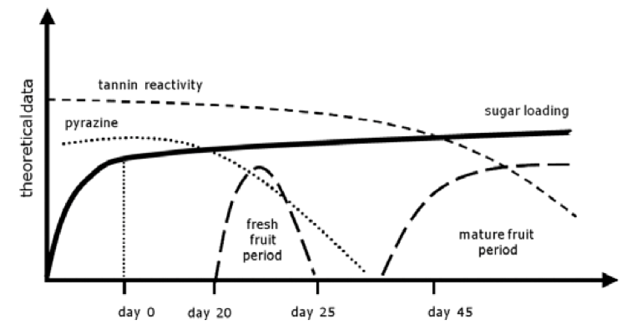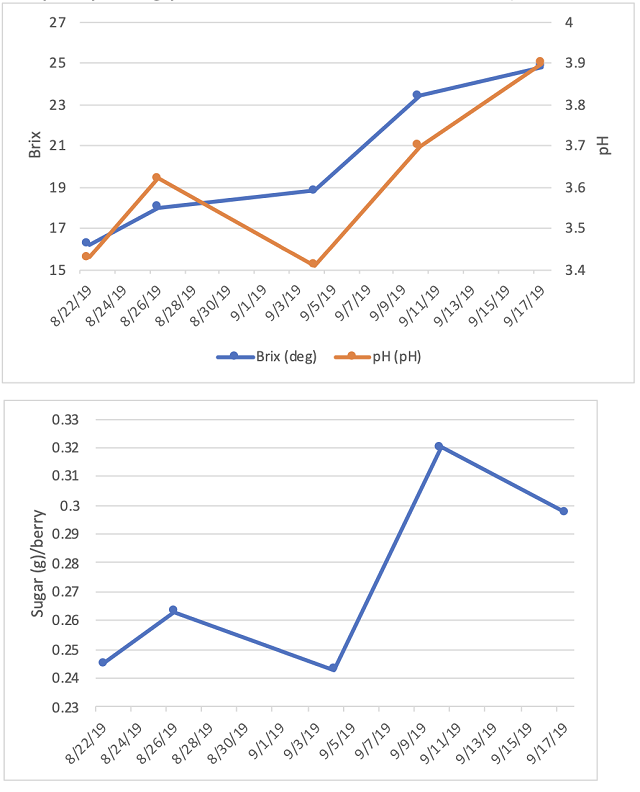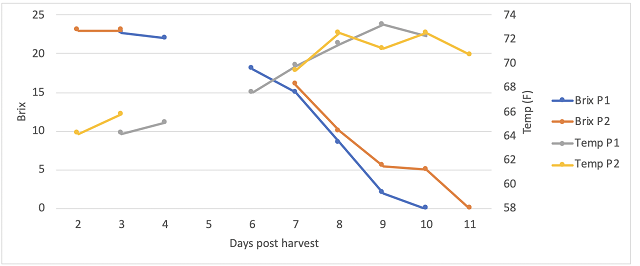Effect of Additional Hang Time on Wine Chemistry and Phenolic Profile of Cabernet Franc
Jake Busching and AJ Greely
Hark Vineyards
Introduction
“The timing of the grape harvest determines the maximum wine quality potential thereafter” (Zoecklein, 2001)1
Several measures of fruit maturity are commonly used in Virginia vineyards, but none is a perfect indicator of ripeness1–4. Sugar content, as measured by °Brix, is one of the most commonly used metrics. It is easy to measure, fairly uniform across the population of grapes, and can be an indicator of the primary metabolism of the plant2. Though sugar accumulation is not always correlated to the production of flavor and aroma compounds2, and that correlation is weaker in warm regions (like Virginia) than cooler regions1, the accumulation of sugar does provide a glimpse into the physiological state of the vine and its interaction with the environment5.
However, measuring Brix alone can be misleading due to the dynamics of sugar and water accumulation in the grape berry. This is even more difficult in Virginia, when periodic rain events during harvest make it difficult to know if a stall in Brix accumulation is due to dilution or the end of sugar production. In 2019, the Winemakers Research Exchange tracked Brix and berry weight in several vineyard trials and used this data to calculate sugar per berry.
Sugar is transported from the leaves to the grape dissolved in water, so as sugar loading occurs during ripening, the grape berry is also getting larger. At some point, the vine stops loading sugar into the grape, which also means less inflow of water. The grape berry also loses water through transpiration such that when sugar loading has ceased, any increase in Brix is no longer due to ripening, but rather dehydration. Physiological ripeness, then, can be defined as that point when the grape has reached its maximum sugar per berry5.
Sugar per berry can be calculated using °Brix and berry weight, measurements already taken at most wineries. The °Brix is equal to the total soluble solids in 100 g of juice, and sugar makes up 90-95% of those solids6, allowing an estimate of the concentration of sugar per berry as follows:
(°Bx /100) * grams/berry = sugar per berry (g/berry)
For a 100 berry sample that weighs 112 grams and measures 22°Bx,
(22°Bx/100) * 1.12 = 0.246 g sugar per berry
Practically, it is best to take a representative sample of at least 100 berries and weigh them on a scale that is accurate to at least 0.1 grams. Plotting the results of weekly samples over time (with more frequent sampling close to harvest) is needed to determine the change in sugar per berry during ripening.
In red grapes, phenolic ripeness is often reached after physiological ripeness7, (Figure 2 from Deloire, 2011), but the timing of the end of sugar loading is still informative. It is thought that the amount of time from the end of sugar loading can be used to determine the evolution of aroma and flavor compounds as well as tannins. These changes mark the transformation of grapes from those that would result in fresh young red wines to those useful for more structured, age worthy red wines. With this in mind, sugar loading can be used in conjunction with other parameters to pick for a desired wine style. A balanced red wine is thought to come from grapes picked one to five weeks after the cessation of sugar loading, with the difference in duration largely due to the intended style of the wine. For fresh, young reds, the grapes would be picked 1-2 weeks later, to allow vegetal elements to decrease and desirable flavor metabolites to be formed. For more structured reds, a longer wait is needed to allow for the evolution of tannin reactivity7. Regardless of the desired wine style, measuring sugar per berry provides a starting point for the “maturation” clock.
Figure 1: From Deloire7, depicts the berry aromatic sequence in relationship to sugar loading and wine style. Once sugar loading has slowed down or stopped (“day 0”), the “physiological” clock begins, with flavors evolving as time progresses.

This study is one of four examining ripening kinetics of red grapes in Virginia during the 2019 growing season. For each location, grapes were sampled beginning 2 weeks after veraison, assessed for traditional measures of ripening as well as sugar per berry. In two of the four locations, the block was harvested twice, approximately one week apart, and wine was made separately from each harvest date. Wines were assessed for general chemistry, color, and phenolics. Sensory impressions of the winemakers are also included.
Methods
This experiment was conducted at Hark Vineyards near Earlysville, Virginia in a single (13 row) block of Cabernet Franc (clone 327 on 101-14 roostock) planted in 2016. The vineyard design is oriented north-south on 9 foot by 4 foot spacing trained to modified ballerina with a Western skirt. This block of Cabernet Franc was sampled weekly beginning 2 weeks after veraison for a total of 5 sample points. Ripening kinetics (Brix/pH/TA) were reported by the winery at each collection event. Sugar per berry during ripening was calculated according to Deloire (2011) and Zoecklein et al (1995).
Given that °Bx = grams sugar/100ml H20 and 100 ml H20 = 100 g H20, then:
(°Brix * weight of 100 berry sample)/100 = grams of sugar per berry
The vineyard was picked in two passes, every other row, 6 days apart to assess effect of phenolic ripening on the resulting wine. The deciding factors in the short duration between picks was vine shut down due to drought conditions and a red mite flare up after Japanese beetle sprays.
All other winemaking procedures were the same for both lots with the exception of maceration time. Fruit was hand harvested and refrigerated overnight prior to destemming to TBins for fermentation. Additions included: SO2 at destemming (70ppm), Color Pro (80 ml/ton) the following day and tartaric acid (1.5 g/L) four days after destemming. Nobile Fresh granular oak (3g/L) was added after 5 days. Fruit was inoculated on the third day after destemming with D21 yeast (0.25 g/hL)(Scottlabs) rehydrated in Go Ferm (20 g/hL). Fermentations were punched down twice daily until the completion of fermentation, at which time they were punched down once daily. Each was monitored once daily for Brix and temperature. Wine for the first pick was drained and pressed after 25 days total maceration while the second pick only received 19 days of total maceration time. Free run and pressings were combined. After one day of setting, wine was racked to barrels for malolactic fermentation. Progress of malolactic fermentation was monitored with paper chromatography and confirmed with enzymatic analysis. Due to restrictions put in place during the COVID-19 pandemic, these wines did not receive sensory analysis.
Results
The days between the first pick (9/10) and the second pick (9/16) were very hot. Little sugar accumulation was seen due to these additional days, instead, there appeared to be a decrease in sugar per berry and an increase in pH of 0.2 units (Figure 2). The additional 6 days of hang time increased Brix (from 23.4 to 24.8), however, sugar per berry decreased (Figure 2), indicating that increased Brix was likely due to dehydration rather than additional sugar loading.
Neither color nor total phenolics were increased due to additional hang time, according to in-house phenolic measures (Figure 3). Grape phenolic analysis conducted at ETS labs (St. Helena, California) also did not find large differences from one harvest date to another (Table 1).
Once in the winery, fermentation progressed fairly consistently between the picks (Figure 3). There were no notable differences in phenolics or anthocyanins in the finished wine (Tables 1&2). In this case, additional hang time did not benefit phenolic maturity, likely due to vines shutting down. It is possible that additional hang time increased flavor and aroma compounds not measured in this study.
Figure 2: Grape ripening parameters for Cabernet Franc (in-house data, WRE)

Figure 3: Fermentation kinetics for two picks of Cabernet Franc (in-house data)

Table 1: Grape phenolic measurements (mg/L) for two harvest dates of Cabernet Franc
(ETS labs)

Table 2: Anthocyanins in wine from Cabernet Franc harvested 6 days apart (mg/L) (ETS Labs)

Table 3: Phenolic compounds in wine from Cabernet Franc harvested 6 days apart (ETS Labs)

References
(1) Zoecklein, B. W. Grape Sampling and Maturity Evaluation for Growers https://www.apps.fst.vt.edu/extension/enology/VC/Jan-Feb01.html (accessed Oct 30, 2019).
(2) Bisson, L. In Search of Optimal Grape Maturity. Practical Winery and Vineyard Journal 2001.
(3) Plessis, C. S. D. Optimum Maturity and Quality Parameters in Grapes: A Review. South African Journal of Enology and Viticulture 1984, 5 (1), 34–42. https://doi.org/10.21548/5-1-2367.
(4) Conde, C.; Silva, P.; Fontes, N.; Dias, A.; Tavares, R.; Sousa, M.; Agasse, A.; Delrot, S.; Gerós, H. Biochemical Changes throughout Grape Berry Development and Fruit and Wine Quality. Food 2006, 1.
(5) Bernard, N. The Berry Sugar Loading : An Indicator of Grape Quality – Vintage Report Blog, 2017.
(6) Zoecklein, B.; Fugelsang, K. C.; Gump, B. H.; Nury, F. S. Wine Analysis and Production; Springer: New York, 1995.
(7) Deloire, P. A. The Concept of Berry Sugar Loading. Wineland Magazine, 2011.
